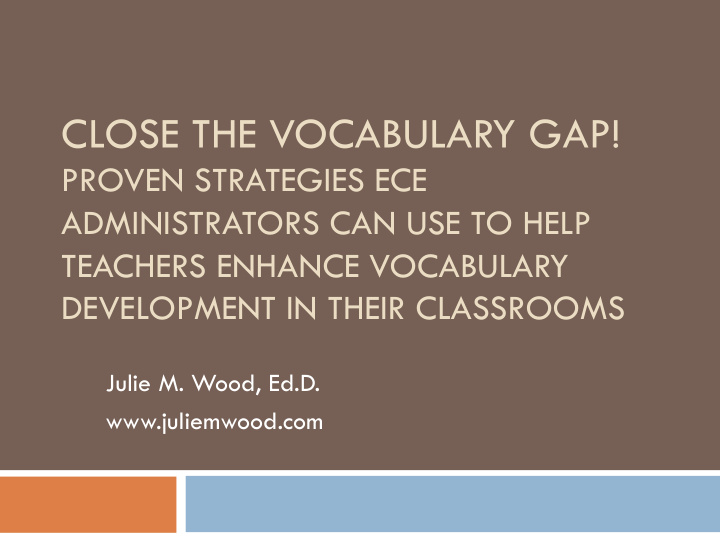



CLOSE THE VOCABULARY GAP! PROVEN STRATEGIES ECE ADMINISTRATORS CAN USE TO HELP TEACHERS ENHANCE VOCABULARY DEVELOPMENT IN THEIR CLASSROOMS Julie M. Wood, Ed.D. www.juliemwood.com
Is Developing Young Children’s Vocabulary Knowledge Really that Important? ¨ YES! ¨ Achievement gap begins as early as age three (30 million word gap between children in low income settings compared to those in affluent settings) * ¨ Research was conducted with 42 families in Kansas City. ¨ Children in low-income settings heard, on average, 616 words per hour compared to children in more affluent settings who heard, on average, 2153 words per hour. * Hart, B. & Risley, T. (1995). Meaningful differences in the everyday experience of young American children. Baltimore: Paul H. Brookes Publishing.
Implications of Findings ¨ High correlation between three-year-olds’ lexical (vocabulary) knowledge and language proficiency at ages 9 and 10. ¤ Vocabulary ¤ Listening ¤ Syntax ¤ Reading Comprehension
What Else Do We Know About Children’s Vocabulary Development? ¨ Knowledge about words and their meanings is essential to understanding and interpreting text. ¨ Low–SES children enter school with less-extensive vocabularies than their middle-class peers. ¨ Middle-class children have learned about 6,000 root word meanings, compared to 4,000 by their lowest-quartile classmates, by second grade (a 2- grade gap). (Neuman, Newman, Dwyer, Reading Research Quarterly, 2011).
More. . . ¨ More fortunate students know more academic words , which helps them make cognitive links (“Velcro of the mind). ¨ These differences in word knowledge contribute to the achievement gap. ¨ Most schools do not invest time in direct vocabulary development. ¨ Teaching tools offer little guidance for teachers in vocabulary instruction.
How Can WE Bridge the Gap? ¨ My own interest in children’s vocabulary development. ¨ How administrators can make sure that vocabulary learning becomes an even more essential—and exciting!—part of early child education? ¨ Question: When we teach vocabulary, should we do so in a purely organic way as new words arise, or teach children a prescribed list of words?
What can Teachers and Administrators Do Right Away? ¨ Read books aloud often–interactively. Select titles that feature rich vocabulary (more on this soon). ¨ Teach words thematically (for example, building word webs– garden, plant, flower , vegetables ). ¨ Use media to help convey concepts ( e.g., video clips, songs, photos).
What You Can Do Right Away ¨ Dialogic reading at home and school. ¨ Oral development on the go. ¨ Reading fiction and nonfiction texts aloud to children.
Provide Time for Vocabulary Instruction ¨ Research shows that as little as 12-15 minutes a day can make an important difference (when added to a core literacy program). ¨ Remember: Children benefit from lots of interactions around words, especially content area words. Math is key (with words such as: add, subtract, measure, forward, backward, equal ).
More Strategies ¨ Teaching words for known concepts (sizes, night/day, feelings, noises). ¤ Noises n No Jumping on the Bed (Arnold) n No More Water in the Tub (Arnold) n Koala Lou (Fox) n Walk with a Wolf (Howker) ¤ Feelings n The Way I Feel (Cain) n The Story of Ruby Bridges (Coles) n Look Out, Bird! (Janovitz) n The Day the Goose Got Loose (Lindbergh) ¤ (YOU know LOTS more titles!!) ¨ Teaching new meanings for known words (multiple meanings). ¨ Clarifying and enriching meanings of known words ( angry/peeved; furious/piqued; and perturbed/agitated). (Adapted from: Edna Brabham, Connie Buskist, Shannon Coman Henderson, Timon Paleologos, & Nikki Baugh, 2012)
Bringing Parents into the Equation ¨ Every point of contact with parents is a golden opportunity to share vocabulary development strategies for them to use at home. ¨ Parents are eager to learn tools and strategies!
“There’s an App for That” ¨ Generation Z and Technology ¨ Expert advice: www.commonsensemedia.org ¨ Also see Reading Rockets: http://www.readingrockets.org/teaching/ reading101/vocabulary/literacyapps_vocabulary / ¤ Experiment ¤ Add your own discoveries to the list ¤ Share ideas with colleagues
Words ¨ The great thing about collecting words is that they’re free; you can borrow them, trade them in, or toss them out. Words are lightweight, portable, and they’re EVERYWHERE!” n Susan Woolridge (1997) ¨ Reflect: Which strategies do teachers and administrators in your school use regularly? Which strategies could you emphasize even more?
References ¨ “Educational Effects of a Vocabulary Intervention on Preschoolers’ Word Knowledge and Conceptual Development,” by Susan Neuman, Ellen Newman, and Julie Dwyer in Reading Research Quarterly, July/August/September 2011 (Vol. 46, #3, pp. 249-272). ¨ “Flooding Gaps to Accelerate Word Learning,” by Edna Brabham, Connie Buskist, Shannon Coman Henderson, Timon Paleologos, and Nikki Baugh in The Reading Teacher , May 2012 (Vol. 65, #8, pp. 523-533).
Q & A ¨ Let’s hear from you. ¨ I can be reached at: julie.wood@post.harvard.edu
Recommend
More recommend